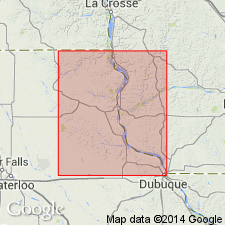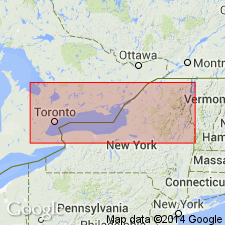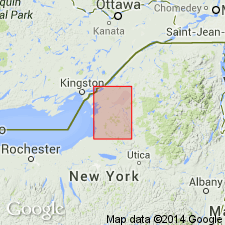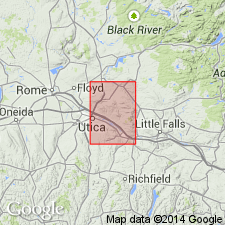
- Usage in publication:
-
- Sherman Fall formation
- Modifications:
-
- Original reference
- Dominant lithology:
-
- Limestone
- Shale
- AAPG geologic province:
-
- Appalachian basin
Summary:
Pg. 664-671; see also GSA Bull., v. 46, p. 225-244, 1935. Sherman Fall formation of Trenton group (name suggested by J.J. Galloway). Here defined as the "PRASOPORA beds" or Trenton restricted of Raymond, Johnston, and others. Includes about 105 feet of thin-bedded limestones with shaly partings, extending to seam in cliff of upper High Fall about 20 feet from top of fall. Comprises zones F to K of Raymond (Bull. Amer. Paleo., no. 17, 1903) and zone A5 and most of overlying zone A6 of Prosser and Cumings. Its base, a bed in which PRASOPORA SIMULATRIX ORIENTALIS is abundant, lies immediately above a stratum of massive dark-blue limestone about 3 feet thick that is conspicuous in side of Trenton Falls Gorge along path above Sherman Fall, the bed A4 of Prosser and Cumings (New York State Geol. 15th Ann. Rpt., p. 615, 1897). Is younger than Hull formation and older than Lower Cobourg. Age is Middle Ordovician.
Named from Sherman Fall, in Trenton Falls Gorge of West Canada Creek, Oneida Co., central NY.
Source: US geologic names lexicon (USGS Bull. 896, p. 1984-1985).

- Usage in publication:
-
- Sherman Fall formation
- Modifications:
-
- Revised
- AAPG geologic province:
-
- Appalachian basin
Summary:
Pg. 263-268, 271. Sherman Fall formation of Trenton group. Overlies Hull formation and underlies Cobourg limestone in northwestern New York and Ontario. Type section lacks exposure of about 30 feet of base of formation, but total thickness in vicinity is about 200 feet. Comprises Shoreham and Denmark members (both new). In Oneida County, includes Dolgeville facies. Age is Middle Ordovician.
Source: US geologic names lexicon (USGS Bull. 1200, p. 3575).

- Usage in publication:
-
- Sherman Fall formation
- Modifications:
-
- Revised
- AAPG geologic province:
-
- Appalachian basin
Summary:
Pg. 525-535. Sherman Fall formation of Trenton group. In this report, Shoreham and Denmark members are raised to formational rank.
Source: US geologic names lexicon (USGS Bull. 1200, p. 3575).

- Usage in publication:
-
- Sherman Fall formation
- Modifications:
-
- Revised
- AAPG geologic province:
-
- Appalachian basin
Summary:
Pg. 42. Sherman Fall formation of Trenton group. Sherman Fall was originally defined as "the 'PRASOPORA beds' or 'Trenton (restricted)' of Raymond, Johnston, and others." It was originally supposed to include beds now classified as the whole of the Russia and lower half of Rust limestone at Trenton Falls, 105 feet of beds above Sherman Fall; subsequent study shows that the "PRASOPORA beds" correspond to the Shoreham and Denmark formations of this report [Utica quadrangle].
Source: US geologic names lexicon (USGS Bull. 1200, p. 3575).
For more information, please contact Nancy Stamm, Geologic Names Committee Secretary.
Asterisk (*) indicates published by U.S. Geological Survey authors.
"No current usage" (†) implies that a name has been abandoned or has fallen into disuse. Former usage and, if known, replacement name given in parentheses ( ).
Slash (/) indicates name conflicts with nomenclatural guidelines (CSN, 1933; ACSN, 1961, 1970; NACSN, 1983, 2005, 2021). May be explained within brackets ([ ]).

